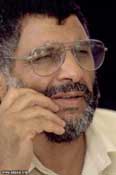Abd al-Aziz Rantissi

(1947 - 2004)
Abd al-Aziz Rantissi was a Hamas leader and head of activities in the Gaza Strip.
Rantissi was born in Yubna, near Jaffa.
In 1948, his family moved to the Gaza
Strip. He was an outstanding student. He completed his secondary
school education in 1965 and was admitted as a student to the faculty
of medicine at Alexandria University (Egypt). He graduated in 1972,
returned to Gaza for two years, and than obtained a masters degree in
Pediatrics.
Rantissi studied in Egypt for nine years and received
a degree in pediatric medicine. While there, he was influenced by the
philosophy of the Muslim Brotherhood.
In 1976, he returned to Gaza and became part of the
Muslim Brotherhood movement. He also worked as a resident physician
at Nasser Hospital (the main medical centre in Khan Yunis). He occupied
several posts in public works such as a member in the administrative
board of the Islamic Complex, Arab Medical Society in Gaza, and the
Palestinian Red Crescent Society.
Rantisi joined the Faculty of Science at the Islamic
University of Gaza when it opened in 1978 and also became Chief Pediatrician
in the Government Hospital in Khan Yunis. In 1983, he was arrested for
refusing to pay taxes to Israel. On January 15, 1988, he was again arrested
for 21 days.
In September 1987, four residents of the Jabalya refugee
camp in Gaza were killed in a traffic accident. According to Rantisi,
he joined with Sheikh Ahmad
Yassin, 'Abdel Fattah Dukhan, Mohammed Shama', Dr. Ibrahim al-Yazour,
Issa al-Najjar, and Salah
Shehadeh and instructed people to exit the mosques chanting "Allah
Akbar" (God is great). This was how the first intifada began, says Rantisi, under the leadership of what would subsequently
be known as Hamas. The PLO later joined and a
united leadership was formed. On March 4, 1988, Israel arrested him
for his participation in the Intifada. He was released on September
4, 1990. On December 14, 1990 he was again arrested and placed in administrative
detention.
In December 1992, he was expelled to Lebanon,
as part of the expulsion of 416 Hamas and Islamic Jihad operatives,
and emerged as general spokesman of those expelled to southern Lebanon.
Upon his return in 1993, he was arrested, but later released.
Rantissi was detained many times by the Palestinian
Authority for his criticism of the PA and Arafat,
but in most cases, was released after a short period.
After the return of Sheikh
Yassin to the Gaza Strip in October 1997, Yassin,
together with the senior operatives including Rantissi, reorganized
the Hamas leadership
in the Gaza Strip to restore
its activity.
In mid-1999, following his release from a PA prison,
Rantissi returned to his position as "right hand" to Yassin.
During talks among the Hamas leadership in Gaza and abroad and in its contact with the PA regarding
ceasing terror activity, Rantissi, together with Ibrahim Macadma and
with the support of the external leadership, was one of the main opponents
to any cease-fire and cessation of terrorist attacks inside Israel.
Abd al-Aziz Rantissi replaced Salah
Shehadeh and Ibriahim Macadma, after they were assassinated by Israel,
as the head (along with “spiritual” leader Yassin) of Hamas and its principal spokesperson.
Hamas tries to present a separation between the political leadership and the
military wing, as if the military activity serves no political aim.
In practice, the formal "military leadership" of the Hamas is subordinate to what is known as the "political leadership."
However, it is this "political echelon" of the terrorist organizations,
which directs, instructs and determines policy, including terrorist
activity. Interrogation of Hamas operatives point to Rantissi as directing Hamas terrorist policy. His public statements serve as instructions for terrorists
to carry out attacks.
Rantissi
has considerable influence over the Palestinian public, in general and
the Hamas operatives,
in particular. He delivers sermons, addresses, and interviews utilizing
extreme language, in which he calls for the continuation of the terrorist
activity against the State of Israel and its citizens, opposing any
cease fire. This serves as instructions to the field operatives in the Gaza Strip and the West
Bank to continue their terrorist activity.
The Hamas leadership in Gaza is also involved in the recruitment and operation
of terrorist cells among Israeli Arabs, which has so far, been thwarted
by Israeli security forces. Rantissi was directly involved in directing
and guiding this activity.
Rantissi
is responsible for directing many terrorist
attacks by Hamas,
including the June 8, 2003, attack in which four Israeli soldiers were
killed at the Erez Checkpoint in the Gaza Strip. Following this attack,
Israel unsuccessfully attempted to assasinate Rantisi on June 10.
Upon the assassination of Sheikh
Ahmed Yassin on March 22, 2004, Rantissi was named head of Hamas's
activities in the Gaza Strip.
On April 17, 2004, Israeli security forces killed Abdel
Aziz Rantisi.
Sources: IDF,
PASSIA, Kul
al-Arab, (January 9, 1998) |